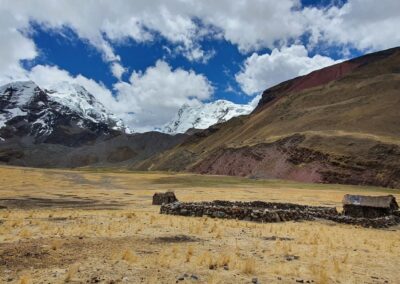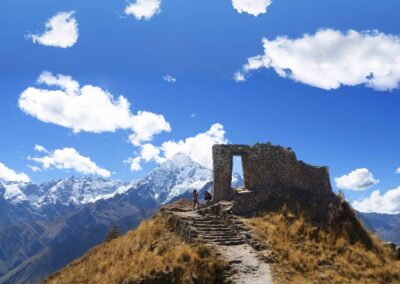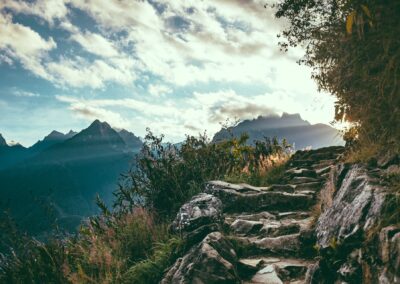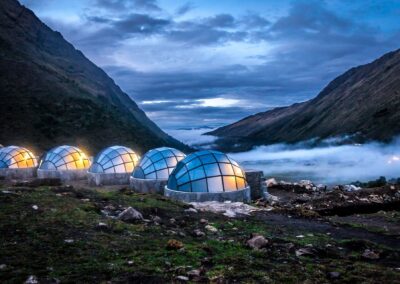Hike to Machu Picchu by Lares
4 Days / 3 Nights
ACTIVITIES
Hike, Camping
DURATION
4 Days / 3 Nights
MAX. ALTITUDE
4,450 mts
LOCATION
Lares, Machu Picchu, Cusco
Introduction
A traditional and experiential adventure is offered by the experience of the Lares Walk 4 days and 3 nights along a path full of history and still-living tradition of the towns we will find.
This experience gives us endless emotions from the first day visiting some beautiful hot springs in a valley full of Flora and Fauna, this allows us to discover that nature is our best refuge from the routine and stress that may exist on a daily basis. day.
This experience is intended for all people who have an adequate and optimal state of health in the face of the necessary requirement, you can do it individually to be able to meet new people, as a couple or with friends with whom to share emotions and also as a family to live a unforgettable adventure.
Get inspired for your next vacation with testimonials from traveling customers like you!
Why book this tour?
Enjoy the relaxing Lares Hot Springs.
Discover the story behind Pumamarca.
Tour the beautiful Inca citadel and surroundings.
Enjoy the magical train ride in its various classes.
Capture the best shots from the House of the Guardian.
Discover the mystery about the Intihuatana.
Fall in love with the Inca culture with its living history.
Taste and participate in the preparation of food.
Summary Itinerary
Day 01: Cusco – Lares – Wacahuasi
- 06:00 – 09:00 Pick up from the hotel and transfer to the town of Calca where we can visit the local market.
- 09:00 – 11:00 We continue the tour to the Lares sector to visit the thermal baths.
- Free time to enjoy the hot springs and to have lunch in this place.
- 13:00 – 17:00 Start of our walk to reach the town of Wacawasi to learn about its history.
- 17:00 – 17:30 Climb up the mountain to reach our first camp.
- Camping night
Day 02: Wacahuasi – Ipsaycocha – Patacancha
- 08:00 – 11:00 After our breakfast, our ascent begins again through the puna area to reach the highest pass called Ipsaykassa.
- Free time to enjoy the place and be able to take the best photos of the day contemplating the wonderful flora and fauna of the place.
- 11:00 – 11:30 We begin the descent to the Ipsaycocha lagoon.
- Free time to enjoy our lunch and enjoy the surroundings.
- 14:00 – 16:00 We continue with the tour until we reach the traditional town of Patacancha where we will spend the night in a comfortable camp.
- Camping night
Day 03: Patacancha – Pumamarca – Aguas Calientes
- 08:00 – 10:00 After breakfast we will have a local transport to reach Pallata where we will begin to ascend to Pumamarca.
- 10:00 – 13:00 We will continue along an ancient Inca trail until we reach some agricultural terraces. From there we will descend until we reach the town of Ollantaytambo.
- Free time to have lunch and say goodbye to our support staff.
- 15:37 – 17:02 Travel by train from Ollantaytambo to Aguas Calientes. (Vistadome service).
- Hotel night in Aguas Calientes
Day 04: Machu Picchu – Cusco
-
06:00 – 07:00 Ascent by bus we will ascend to the majestic Inca city of Machu Picchu.
- 07:00 – 09:30 Guided tour with visits to the most important sites of the archaeological group of Machu Picchu.
- Descent by bus to Aguas Calientes from Machu Picchu.
- Free time in Aguas Calientes to have lunch, visit the town or the thermal baths (own expense).
- 16:22 – 18:10 Return train from Aguas Calientes to Ollantaytambo. (Vistadome service).
- 18:10 – 20:10 Travel by Van from Ollantaytambo to your hotel in Cusco.
- Hotel night in Cusco (Request your reservation with us)..
Detailed Itinerary
During our adventure we will be able to pass through different places that hold a mystery and a beautiful view during the 4 days of walking until we finally reach Machu Picchu on the last day with all the energy to know this World Wonder, the places that we will be able to see are:
- Lares: Lares is a town located on the heights of the city of Calca, its peculiarity is its famous thermal baths that are thermo-medicinal. The Thermal Baths of Lares are made up of a group of four pools with different temperatures between 36°C and 44°C with a depth of no more than one and a half meters. They also offer us comfort and stress relief, since they contain a large percentage of minerals such as sodium, potassium, magnesium, calcium, iron, zinc and others. It is very similar to those of Cocalmayo and Aguas Calientes.
- Pumamarca: Its location allows us to appreciate the Patacancha valley and also the Yuracmayo valley. We can find constructions such as terraces, canals, colcas, among others. The enclosures are located around a central courtyard and have very high doors and walls, which indicate that they probably served as a fortress.
- The archaeological complex of Pumamarca also contains a great mystery because nothing is known about its origin or its function. Some researchers concluded that it was a place of control for Antisuyo, although due to its dimensions it is likely that it was a multifunctional center.
- Guardian House: This beautiful place is located in the highest area of the Inca citadel on the Agricultural Area. Its function was to control the entrance to the Inca city and review the entire agricultural and urban area. From here you can see a panoramic view of the entire citadel and the entrance to the old Inca trail. It has three walls: In the central wall we find three large windows, which allow us to easily observe the entrance to the Inca trail and the Inca bridge, the only means of communication with the outside world. We can also see how the Incas covered the enclosures with a ichu roof.
- Llacta Punku: It is the income for the urban sector, it is located limited by a deep excavation. This sector is located from the cemetery by a long staircase towards the peripheral neighborhoods, it has a system of points to hold a wooden door, in person and not as an element of restriction or security since the city can also be accessed by other roads.
- Ceremonial Plaza: It is a set of enclosures made around a quadrangular patio, you can see three polygonal walls, made with immense stone pieces assembled perfectly. The presence of three windows and two niches on each side stands out. It is considered that the function of these windows was probably purely religious, next to this we can find a different enclosure called The House of the Priest.
- Temple of the Sun (1:00 p.m. – 4:00 p.m.): This enclosure has a finely polished two-story structure: the first is semi-underground and the second features a beautiful semi-circular wall with perfect finishes, with an incline towards its interior due to what is called “Torreón”. It was used to celebrate religious ceremonies, especially during the months of June and December, special dates for the Solstices.
- This Tower has two trapezoidal windows, one oriented towards the most extreme point of the winter solstice that takes place on June 22 and the other oriented towards the Puerta del Sol (Intipunku) for the summer solstice that occurs on June 22. from December. In the middle of this architecture we can find a central rock, polished in the shape of an altar that was used for the ceremonies of interpretation of the path that the sun followed. It is built on a large rock, under which there is a small cave, which has been worked and covered with a thin wall, this is because it probably fulfilled the function of a mausoleum, because it has niches of a moderate size, where they placed the mallquis or mummies where they were worshipped.
- Temple of the 3 windows: This enclosure has three polygonal walls, built with enormous stone pieces perfectly assembled, highlighting 3 windows and 2 niches at each end. The function they had was religious magic and not only aesthetic.
- It was Hiram Bingham who carried out excavations in the front part of this temple, finding a large amount of fractured ceramics and highlighting the detail of the bases of this temple with a depth of more than three meters, here is also the possible symbolic figure of the head of a carved llama, this image is allegorical to the camelid because of the importance it had as a beast of burden, supplier of meat and clothing to the Incas.
- Main Temple: It has a finely polished structure with beautiful finishes, an enclosure framed by only three walls, each of the large pieces have been carefully crafted. The central wall has a dimension of 11 meters. Behind the Main Temple there is an enclosure whose function was probably also for religious use according to the records obtained and whose stones have no less than 32 angles, which makes its meaning quite mysterious.
- Intihuatana (07:00 a.m. – 10:00 a.m.): It bears his name in Quechua which translated means "where the sun hangs“, is an area that corresponds to one of the highest sectors of the Urban Zone. This is the most important area of Machu Picchu, at the top of this area we can find a huge sculpture made and carved with flat surfaces, a column of 66 cm. tall and with finely carved faces that complement the sculpture. The total space of the Intihuatana measures 8.60 meters and 1.76 meters high.
- The Intihuatana, is one of the most enigmatic objects of Machu Picchu, it is related to the sunrise and the mountains. The movement of the Sun causes projections of shadows at different times, this served to recognize and interpret them in different periods of the year.
- Sacred Rock: It is a carved stone that resembles the silhouette of a mountain. It is located next to the control point to access the Huayna Picchu Mountain, made up of two Huayrana-type environments (three-walled environment), with very high ceilings that face each other forming a small, almost square plaza. This rock has an important location, since it is on the path that leads to two very important sites such as Huayna Picchu and the Temple of the Moon.
- Water mirrors: Its name is in relation to the enclosure where they are found as well as to the constructions that are in the place. It is a wide sector, with a single access door, which is why it is attributed to be an Acllahuasi or House of Selected Women who were dedicated to spinning, cooking and preparing chicha or acja, for the privileged class.
-
Among the possible functions attributed to this space are:
- In one of its rooms, you can see two circular rock protrusions, which have the shape of mortars, they were probably used to grind grains or prepare dyes.
- It is also given the name of 2 water mirrors, because in the rainy season they agglomerate with water and allow us to see the reflected stars.
- Temple of the Condor (10:00 a.m. – 1:00 p.m.): It is a wide set of constructions, made taking advantage of the irregular shapes and on a cave that was notoriously used for ceremonies. The condor was an animal worshiped during Inca times and associated with the divinity of the mountains.
- The area is delimited by stairs and finely carved walls, its access is controlled by a double jamb door, which shows the hierarchy and the activities that took place in this area, it presents a great variety of closed and open environments with one and two levels.
- In the central patio it has as its main point, a carved rock, where the representation of the head and part of the body of a condor can be clearly distinguished. You can see the head, beak and eyes, as well as the necklace of white feathers of the Royal Condor, with the body projected towards the interior of the cave, which subtly joins two natural rocks.
- In this sector you can see the clear union of natural rocks with others worked by man, seeking to represent a tutelary deity. In the underground cave (the body of the Condor) offerings, ceramics and bone remains of camelids were found, which confirm the quality of a "ceremonial center" where offerings were made.
- In front of the temple of the condor enclosure we will find a 2-story structure that has two entrance doors, the second level is flush with the patio of the condor and by observation it must have served as the enclosure of the priest, in charge of the worship of the Condor. You descend to the first level by a staircase that connects to other rooms. In an environment attached to it, sectors for raising animals were found, other stairs lead to a lower platform.
- Water sources: We can see a large staircase next to which runs a system of 16 waterfalls, most of them carefully carved in polygonal blocks and surrounded by gutters made in the rock. The water comes from a spring in the heights of the Machu Picchu mountain that was channeled in Inca times. A separate channel at the top of the mountain also associates the seepage of rain from the mountain and diverts it to the main channel.l.
What's Included?
Included
- Transfer upon arrival: It is done in private transport, from the airport to the hotel.
- Detailed briefing: It takes place before the start of the service (The briefing is a complete orientation, explaining everything about the tour. In addition, any questions you may have about it will be clarified).
- Transfer Cusco – Lares: Travel by private transport: from Cusco passing through the city of Calca and finally to the town of Lares.
- First level guide: Professional tour guide specialized in Cultural tourism (English/Spanish).
- Radio transmitter-receiver: Our main guide and the chef have these teams, for constant coordination in logistics, customer safety, requesting support, etc.
- Oxygen balloon: To instantly resolve any imbalance that occurs as a result of altitude.
- First aid kit: We always carry products to offer adequate first aid. On the other hand, if you are undergoing any medical treatment, do not forget to bring your medications.
- Small groups: We always handle an adequate amount of people, semi-private or private tour style.
- Comfortable tents: We offer 4-person tents for 2 passengers and 2-person tents for 1 passenger. In addition, they are all of the 4-season type, easily adaptable to climatic variations.
- Inflatable mattresses: Also suitable for all weather, waterproof and thermally insulated.
- Full dining room: Tent with chairs, tables, tablecloths, crockery, cutlery set for breakfast, lunch and dinner.
- Kitchen: Independent kitchen tent for groups of more than 5 people. Food is also stored there, with strict hygiene.
- Kitchen with Sustainability: We use biodegradable cleaning products: detergent, dishwasher. Our other products are handled in an ecologically responsible manner.
- Infusion upon awakening: Complimentary herbal tea in your tent, every morning before breakfast.
- Tea time: Also called tea time, is done before dinner, with herbal infusions, coffee, tea, rolls, butter, jam.
- Feeding: 3 breakfasts, 3 lunches, 3 dinners during the trek. Includes lunch at a restaurant in Aguas Calientes on the fourth day, after the Machu Picchu tour.
- Varied snack: Provided every day in a small cloth bag, so you can eat something during the walk. It consists of a fruit, an energy bar or a package of cookies and candies.
- Lunch and dinner: They are buffet or semi-buffet, with a variety of Peruvian and fusion food. Desserts and non-alcoholic drinks are also served.
- Varieties of diets: Vegetarian, vegan and other food are also available at the request of the tourist and at no additional cost. Please request your diet in advance, during the reservation.
- Kitchen staff: Specialist cooks and food preparation assistants, experienced and trained in health.
- Eco-friendly plastic: We have reduced the use of all types of disposable plastic to a minimum. We work with almost 100% reusable plastic or other materials that do not pollute nature.
- Support team: It is the support staff, asemilas and muleteers, with extensive experience and trained to provide the service.
- Tempered water: We offer warm water every day for personal hygiene before meals.
- Small hand towels: They give you more comfort in your personal hygiene.
- Boiled water: It is available to drink, starting on the third day. For the previous days you must buy or bring in your reusable bottle.
- Train ride: From the Ollantaytambo station to the Aguas Calientes station (Vistadome Service).
- Snacks on board: Hot and cold drinks, a small cake.
- Sale of snacks on board: Alcoholic and non-alcoholic drinks, sweets.
- Sanitary facilities: At the station and inside the train.
- 3 star hotel in Aguas Calientes: Central hotel that has a private bathroom, hot water, comfortable rooms, Wi-Fi, luggage storage and breakfast the next day.
- Uphill bus: From the town of Aguas Calientes to Machu Picchu for the guided tour.
- Entrance tickets: Both for the Inca Trail and for the visit to the citadel of Machu Picchu.
- Return bus: From the citadel of Machu Picchu to the town of Aguas Calientes, after the guided tour.
- Train ride: From the Aguas Calientes station to the Ollantaytambo station (Vistadome Service).
- Snacks on board: Hot and cold drinks, a small cake.
- Sale of snacks on board: Alcoholic and non-alcoholic drinks, sweets.
- Sanitary facilities: At the station and inside the train.
- Entertainment: Live music and dance show, fashion catwalk with baby alpaca garments.
- Souvenir sale: Baby alpaca collection.
- Private transport: From the train station in Ollantaytambo to your hotel in the city of Cusco.
- Final transfer: We take you from your hotel to the airport, on the day you indicate (prior coordination with us).
-
Not Included
-
Airfare: Both international and national.
-
Transportation: From Playa to the town of Santa Teresa.
-
Breakfast of the first day. You will need to reserve it at your hotel early, before we come to pick you up.
-
Sleeping bag: It is essential that you have one, that resists up to -18°C. They are stuffed with feathers (we rent them for US$25.00).
-
Entrance to the Huayna Picchu mountain: This walk must be reserved separately, at an additional cost and well in advance.
-
Personal expenses and Tips: How to buy handicrafts, clothes, drinks, etc. Tips are not included either, these are voluntary according to the service received.
-
Travel insurance: It is a very important requirement for your safety and protection, for example in case of a medical emergency, the costs will be much lower.
What To Bring?
Trekking Articles
Backpack (30 or 50 liters), water bottle, trekking shoes, waterproof jacket.
Useful Elements
Passport, cash in soles (additional purchases)
Useful Items
Passport, Cash in soles, Camera, charging cord, Extra batteries.
Clothes
Small backpack, rain poncho (January and February – rainy season), warm clothes.
Health and Care
Sunscreen, sunglasses, insect repelent, sun hat, Small towel, Bottled water, Personal medication.

DIFFICULTY LEVEL
Desafiante




